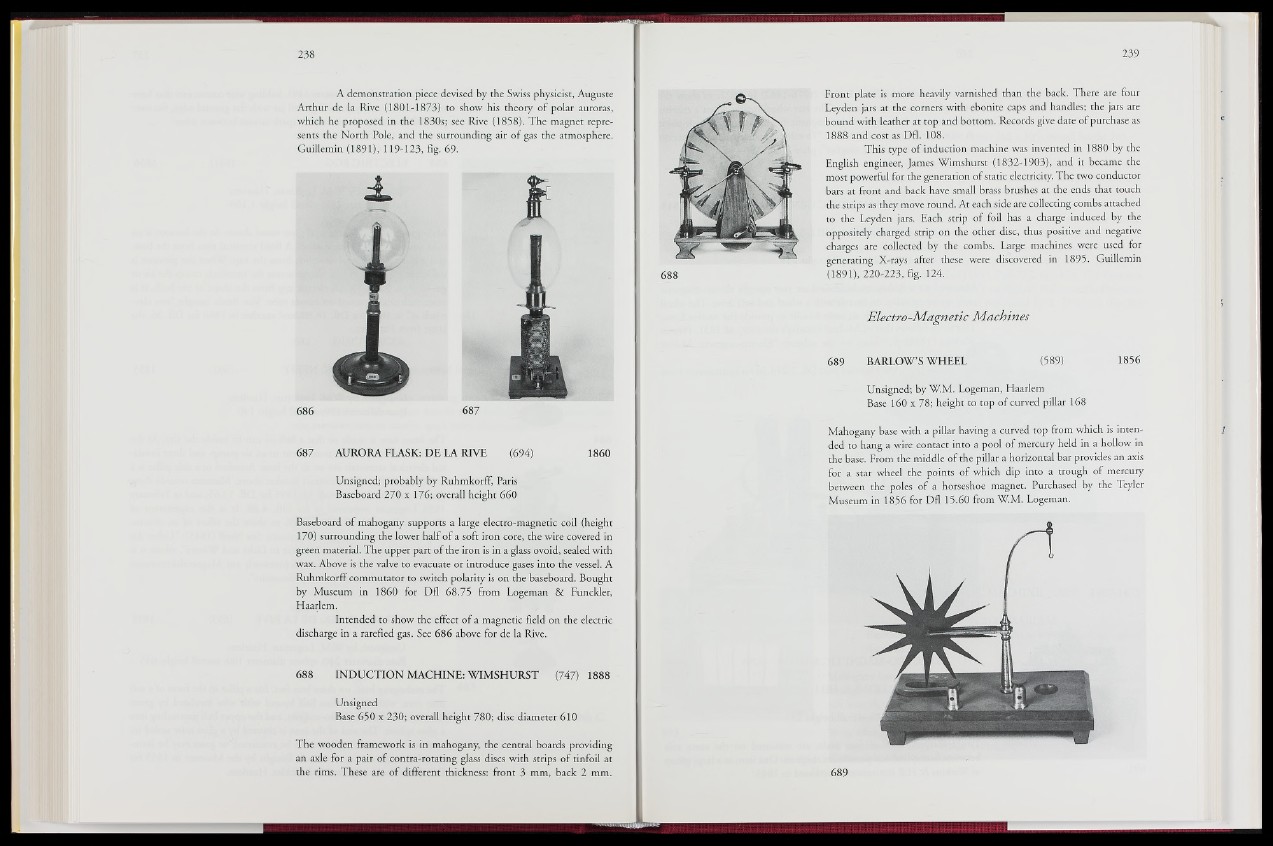
A demonstration piece devised by the Swiss physicist, Auguste
Arthur de la Rive (1801-1873) to show his theory of polar auroras,
which he proposed in the 1830s; see Rive (1858). The magnet represents
the North Pole, and the surrounding air of gas Èie atmosphere.
Guillemin (1891), 119-123, fig. 69.
686 687
687 AURORA FLASK: DE LA RTVE (694) 1860
Unsigned; probably by Ruhmkorff, Paris
Baseboard 270 x 176; overall height 660
Baseboard of mahogany supports a large electro-magnetic coil (height
170) surrounding the lower half of a soft iron core, the wire covered in
green material. The upper part of the iron is in a glass ovoid, sealed with
wax. Above is the valve to evacuate or introduce gases into the vessel. A
Ruhmkorff commutator to switch polarity is on the baseboard. Bought
by Museum in 1860 for Dfl 68.75 from Logeman & Funckler,
Haarlem.
Intended to show the effect of a magnetic field on the electric
discharge in a rarefied gas. See 686 above for de la Rive.
688 INDUCTION MACHINE: WIMSHURST (747) 1888
Unsigned
Base 650 x 230; overall height 780; disc diameter 610
The wooden framework is in mahogany, the central boards providing
an axle for a pair of contra-rotating glass discs with strips of tinfoil at
the rims. These are of different thickness: front 3 mm, back 2 mm.
Front plate is more heavily varnished than the back. There are four
Leyden jars at the corners with ebonite caps and handles; the jars are
bound with leather at top and bottom. Records give date of purchase as
1888 and cost as Dfl. 108.
This type of induction machine was invented in 1880 by the
English engineer, James Wimshurst (1832-1903), and it became the
most powerful for the generation of static electricity. The two conductor
bars at front and back have small brass brushes at the ends that touch
the strips as they move round. At each side are collecting combs attached
to the Leyden jars. Each strip of foil has a charge induced by the
oppositely charged strip on the other disc, thus positive and negative
charges are collected by the combs. Large machines were used for
generating X-rays after these were discovered in 1895. Guillemin
|j.891)» 220-223, fig. 124.
Electro-Magnetic Machines
689 BARLOW’S WHEEL (589l t 1856
Unsigned; by W.M. Logeman, Haarlem
Base 160 x 78; height to top of curved pillar 168
Mahogany base with a pillar having a curved top from which is inten- 1
ded to hang a wire contact into a pool of mercury held in a hollow in
the base. From the middle of the pillar a horizontal bar provides an axis
for a star wheel the p o inS o f which dip into a trough of mercury
between the poles of a horseshoe magnet. Purchased by the Teyler
Museum in 1856 for Dfl 15.60 from W.M. Logeman.